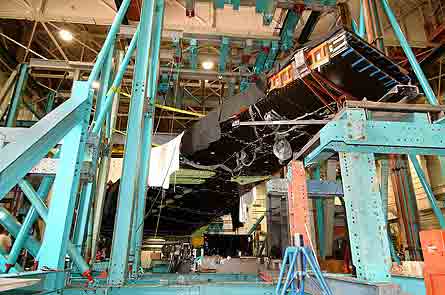Boeing has released the first images of a large prototype for the centre wing box of the 787 twin jet, as Honeywell is selected as avionics partner for terrain avoidance systems.
The 15m (50ft) centre wing section, the longest structure so far built for the new largely-composite aircraft, was unveiled at the company's Everett plant outside Seattle last week, where it will undergo destruction testing. Boeing says the pre-production section came together without serious hitch and will now be handed over to engineers to test for structural integrity. Rival Airbus had to re-test its prototype A380 wing after it broke at a slightly lower threshold than foreseen during testing.
|
|
|---|
Meanwhile the company announced the twin-jet will have terrain-collision avoidance equipment provided by Honeywell, as part of the integrated surveillance system being supplied by Rockwell Collins.
The avionics package will feature Honeywell’s enhanced ground-proximity warning system (EGPWS). EGPWS provides a real-time moving-map display of surrounding terrain to the crew members and alerts them of potential collision risks.
As Boeing racks up sales of the 787, much of the talk here at the show is how the manufacturer is ramping up its production rate and invigorating its global batch of suppliers to meet demand.
Until they can get hold of their first 787 widebodies, the issue for many carriers is what to do with their existing fleets of 757s, 767s and 777s before their replacements begin to arrive. Boeing’s solution to bridge the gap is to upgrade the interiors of these aircraft.
“We have done several deals around the 787 and 777 where in our discussions with airlines the conversation got a lot broader than just the purchase of a new airplane,” says Dan de Silva, vice-president of sales and marketing at Boeing Commercial Airplane Services. “Carriers ask what they can do with their current fleet before they get the first 787 or 777.”
The answer for carriers such as UK leisure carriers First Choice Airways and Thomsonfly, and others in Europe such as Austrian Airlines, is to sign a deal with the manufacturer that produces a revamped cabin based on its 777 Boeing Signature interior. The contract can also include other improvements to the aircraft.
For Boeing this is a logical extension of the life-cycle support approach it is offering airlines.
“We want to partner airlines through all the phases of their ownership of our aircraft,” says de Silva. This includes training, operational improvements, upgrades and converting aircraft to freight models at the end of their passenger-carrying life.
“First Choice is a hallmark example of this life-cycle support partnership,” he says. When the carrier became a launch customer for six 787s in July 2004, it also signed a deal with Boeing to upgrade its fleet of six 767-300ERs, becoming the first European carrier to order Boeing’s 767 Interior Upgrade package. The deal featured several other enhancements to the aircraft to improve its reliability.
Fraser Ellacott, engineering director at First Choice Airways, says: “Our whole strategy is to differentiate the long-haul experience.” Being able to offer an upgraded in-flight experience puts the carrier one step ahead of its competition. “The 767 with the 777 interior is such an enhanced experience that we are pleased because no-one can offer that same product,” he says.
First Choice now has four upgraded 767s in service, with the fifth currently having a new interior fitted at Abu Dhabi-based GAMCO. The final aircraft will be modified by GAMCO later in the summer, says Ellacott.
It is by no means certain First Choice will dispose of its 767s when the 787s arrive. All of the 767s are on operating leases. “We see the 787 as the next phase of our long-term plan, so it is a transition, but we are keeping our options open,” says Ellacott.
Austrian is preparing to put its first 767 into the hangars of Ireland’s Shannon Aerospace in August. In total, the carrier will install Boeing Interior Upgrades on four 767s and three 777s. The retrofit includes a new business-class product with lie-flat seats, new in-flight entertainment system, updated avionics and the installation of Connexion by Boeing, the on-board internet service. The first of Austrian’s 777s is being retrofitted by Lufthansa Technik.
Boeing itself acts as the systems integrator for these upgrades, with a variety of suppliers like GAMCO doing the work. The more complex the task the more chance Boeing believes it has to win this business. Says de Silva: “The market is potentially large in dollar terms – our ability to capture all these modifications depends on the complexity and nature of what our customer wants to do with the aircraft.”
The USA, where hundreds of 767s are in service, is a potentially major market for 767 upgrades. “We haven’t even started to scratch the surface in the US,” de Silva says.
Source: Flight International

















